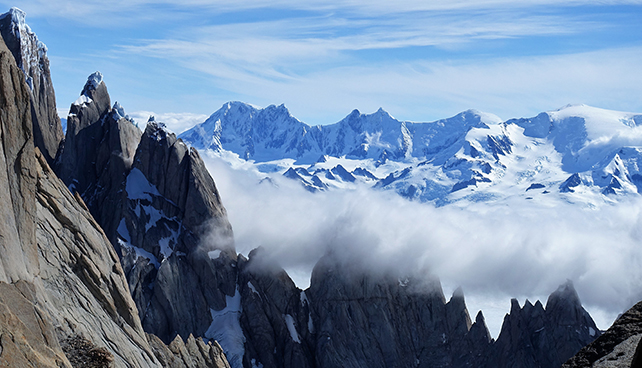
It was two years in the making, and on May 27, the Expedition Climbers Club set off for Peru on one of the largest international mountaineering expedition to leave New Zealand in four decades. Based in the Cordillera Blanca mountain range, the group of 12, including New Zealand Alpine Team members planned to attempt a range of unclimbed routes in the area – ranging from 5000-6000m peaks.
Among the group were some of the country’s top mountaineers, along with mentees from the New Zealand Alpine Team’s youth development program. For these young climbers, this trip was the culmination of three years spent learning the ropes from the team’s highly experienced mentors.
These young climbers – Rose Pearson, Jaz Morris and Peter Harris have taken part in training trips throughout New Zealand, as well as to the French Alps, Canada, Yosemite and Alaska, and the chance to now take on the peaks of Cordillera Blanca had them teeming with anticipation.
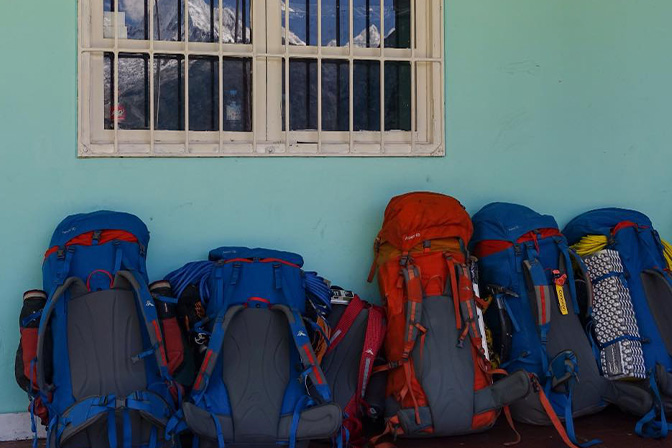
“The expedition to Peru was the culmination of a number of years of learning, training and planning, so we were bubbling with enthusiasm upon landing in Lima and finally making our way to the mountains,” recalls New Zealand Alpine Team mentee Pete Harris.
Over the next five weeks, the group attempted a range of different routes, inspired by an array of historic New Zealand first ascents in the area dating back to the 60s. Taulliraju is one of the world’s most revered mountains, and with so much unclimbed alpine territory, the entire group was excited by the possibilities that lay in front of them.
In the lead up to the expedition, ECC members pored over photographs of Taulliraju, and through vigorous training, thorough planning and an acclimatization process, they made sure they were ready for what lay ahead.
After their arrival in Peru, they traveled to Huaraz where the group spent ten days acclimatizing in the area. This process was so important because climbing at the high altitudes the group was set to experience on Taulliraju can be incredibly hazardous. The key is to give your body enough time to adapt to the lower oxygen levels found at these heights. If not properly acclimatized, you could quickly become unwell with altitude illness.
The group started with a short acclimatization walk up to Lake Churup – a 700m climb which took them to the lake at about 4550m above sea level.
“We ambled up at a leisurely pace, making the lake by lunchtime, followed by a swim at over 4500m above sea level – a personal best for all the team!” says Pete.
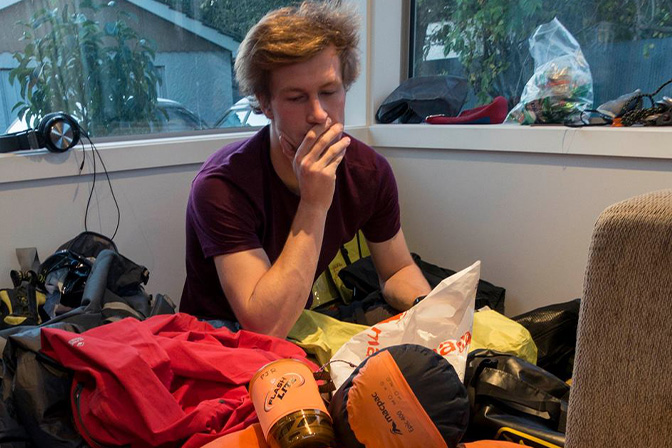
New Zealand Alpine Team mentee Pete Harris enjoys some ‘Pack Tetris’ in the lead up to the group’s departure
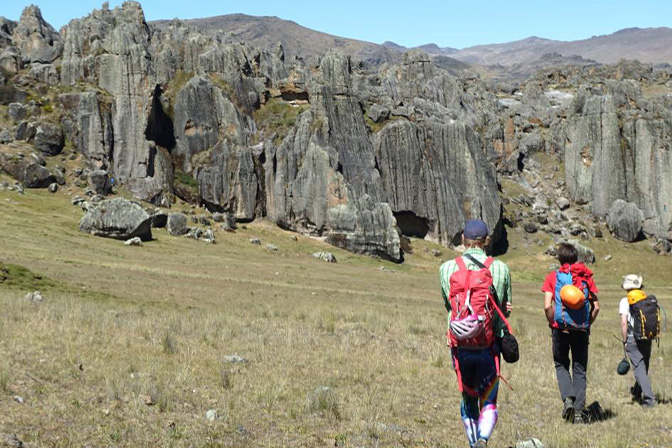
Heading to the crag at Hatun Machay
Following this, the team split into a couple of groups, with some (Ben Dare, Stephen Skelton, Alastair and Lincoln) heading further into the Paron Valley to scope the area out, while others took on some high altitude cragging at Hatun Machay. At 4,300m, Hatun Machay is a glorious high altitude plateau covered with surreal moon-scape style rock outcrops – reminiscent of a volcanic version of Castle Hill. Jaz Morris and Pete Harris remarked on the unique experience that was quite different to climbing in New Zealand.
“It was a truly unique kind of acclimatization to be clipping bolts in shorts and t-shirts over 500m higher than the summit of Mt Cook! While the lack of oxygen showed in the panting after every crux move, and the long-lasting pump, it balanced out with the sheer pleasure of sport climbing in such a spectacular location,” says Pete.
Returning to Huaraz the following day, the next step was to meet up with the others who had ventured into the Paron Valley. Instead of the anticipated two hour walk, Ben informed Jaz and Pete that it had taken them five hours with multiple slips and NZ-style moraines to work around.
“With packs over 30kg, we knew it could prove quite an interesting walk, but we couldn’t wait to get into the mountains to sink the axes into something solid,” says Jaz.
Paron Valley
The Team split off into several groups of 2-3 people, and headed into the Paron Valley in search of summits. Motivated not only by the climb, but also by their cooks who frequently reminded them no cumbre, no cena! (no summit, no dinner!).
The first summit of the trip was attained by experienced climbers and New Zealand Alpine Team mentors Steve Fortune, Daniel Joll and Matt Scholes who took on La Esfinge – The Sphinx. Following this, they headed for the high camp at Piramide de Garcilaso but when they arrived within reach of the summit, they were obstructed by cornice and classic Andean snow. 14 raps, and a mad-dash under a difficult serac resulted in an escaped crampon and Steve spraining his ankle, so they returned to base camp once again for dinner.
‘Summits were elusive for us in the Paron Valley, we were often thwarted by the last section consisting of steep, unconsolidated snow,” says Steve.
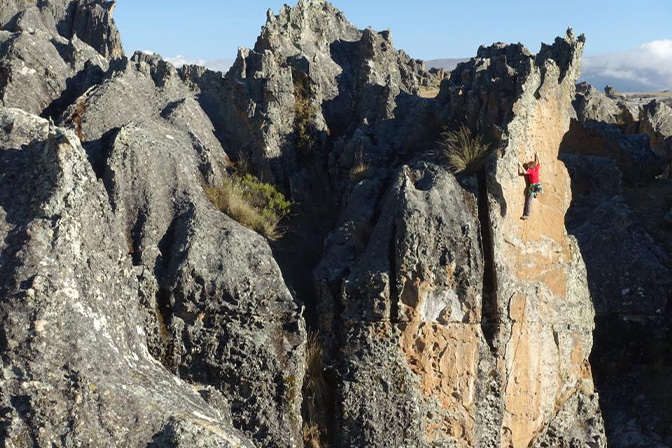
Rose Pearson climbing at Hatun Machay
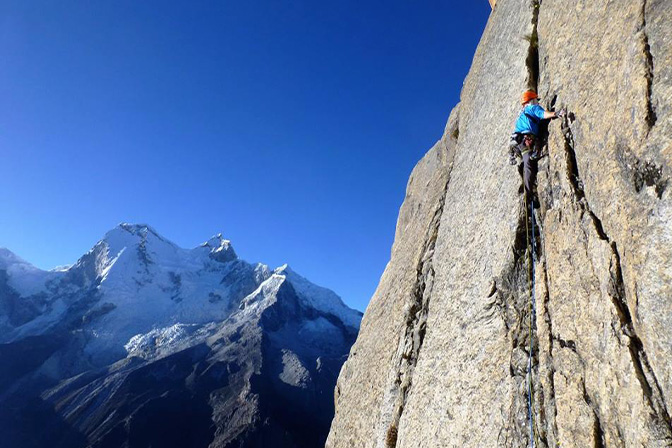
Daniel Joll leading on Esfinge
Meanwhile, Stephen Skelton and Ben Dare acclimatized early and undertook some track maintenance for everyone else. A highlight of the trip was on their second day when they headed up to the Caraz Basecamp (5,000m) to attempt a new line on one of the Caraz Peaks. In an ascent which immediately put the 10+ year old guidebook out of date, they both named and climbed a new peak – scaling ‘Caraz IV’ within 30m of the summit. However, they were halted just below the ridge by a Peruvian cornice which collapsed right in front of them. Following this, the pair scurried down, arriving back at the Paron basecamp just in time for dinner. With a range of food from friend trout to endless soups and fresh meat all the way through to their tenth day, there was always an incentive to never miss dinner wherever possible.
“Our chefs fed us well – with a range of food from fried trout to endless soups and fresh meat all the way through to our tenth day – so there was always incentive to never miss dinner wherever possible,” says Ben.
Alastair McDowell had the advantage of a week’s extra acclimatization along with a previous ascent of ‘The Sphinx’ with the group’s in-country liaison, Aritza Monasterio just before everyone else arrived in Peru. On a similar schedule to Ben and Stephen, Alastair joined up with Lincoln Quilliam to climb one couloir further than Stephen and Ben. Within earshot of their team mates, they even helped with the naming of ‘Caraz IV’. However, they too faced difficulties with cornices and were short of the ridge. This put them behind for time and they had to instead face the harsh reality of dehydrated food for another night at the high Caraz basecamp.
A couple of days later, Alastair and Lincoln left for Piramide, but this trip was short-lived when fresh snow hampered their efforts and forced a turn around. Keen to persevere, they left gear behind for another attempt. However, at these altitudes, there’s always a risk of illness, and an unventilated tent caused Alastair to become unwell with a small bout of high-altitude asphyxiation so they had to take a midnight descent to basecamp. Lincoln set off for one last summit, on the second-to-last day in the Paron, soloing near to the summit of the North Peak of Piramide via the Paron Glacier.
Illness also struck Claire, Reg and Rose, putting a halt on their plans to head up to ‘The Sphinx’. After a quick recovery for Reg and Rose, the pair left Claire at basecamp while she also battled a mystery food poisoning illness. They decided to join Jaz Morris and Pete Harris who were heading off to take on the mighty Nevado Artesonraju. However, their recovery was short lived, and less than a day into the trip, Rose’s sickness returned so she and Reg headed back to basecamp.
Jaz and Pete pushed on with their plans, but they turned around at 5850m – less than 200m from the summit.
“It was an unassailable distance with the meagre oxygen refusing to flow into your barely acclimatized lungs and muscles, so we headed back to basecamp in time for dinner, before we started discussing our next attempt,” says Pete.
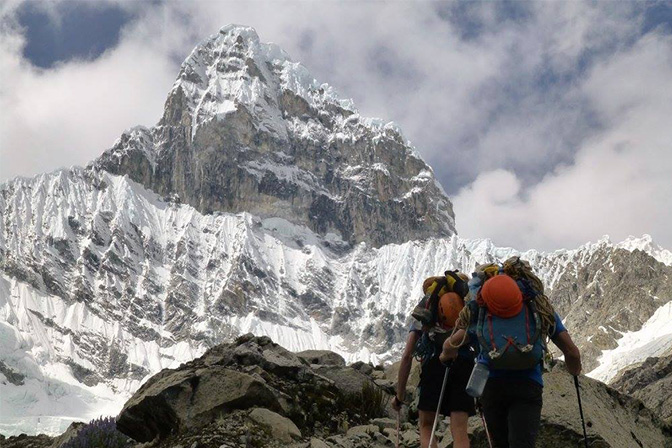
Ben and Alastair heading up to Piramide
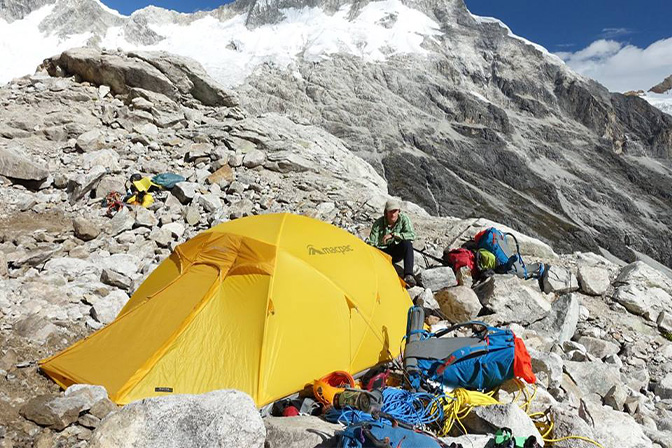
Camp below Piramide
After a failed attempt at Piramide due to poor conditions, Jaz and Pete started to plan take two of Artesonraju. With fresh tactics, the pair went light, camped high, and plugged tracks to the base of the route the day prior.
“Naturally, we woke at 2am to 10cm of snow and no sign of our tracks. So we returned to an uneasy sleep, only to wake at 4pm hoping for a miracle.”
None appeared, so they rose at 6am and embarked on some purposeless wandering, before heading up the Paron Glacier where they struck upon another team’s tracks. A couple of hours and two pitches of glorious aerated Peruvian ice later, and they finally claimed their first summit on the ridge – Paron Sur (5550m).
Taulliraju: Making History
The fierce Taulliraju is one of the hardest mountains in the Andes. Its South Face towers imposingly over the Santa Cruz Valley, with all previous ascents notorious for their difficulty and levels of dedication. New Zealand has a rich history with Taulliraju, with the first attempt from Lionel Clay and Pete Sykes taking place in 1989 where the pair climbed a ‘cunning variation’ on the South Face, coming within shouting distance of the summit.
In the face of adversity and warnings from other mountaineers, the New Zealand Alpine Team had Taulliraju in their sights, and their determination paid off. Thanks to dry conditions across the Andes, the group made the first four ascents, including the first full traverse of Taulliraju, the first New Zealand and Australian ascents of Taulliraju, and potentially the first female ascent of Taulliraju.
There’s an immense satisfaction in seeing the fruits of many years of hard work, perseverance and the continual acquisition of skills garnered from climbing in New Zealand and abroad. Nothing demonstrates this tremendous Kiwi climbing ability better than these ascents.
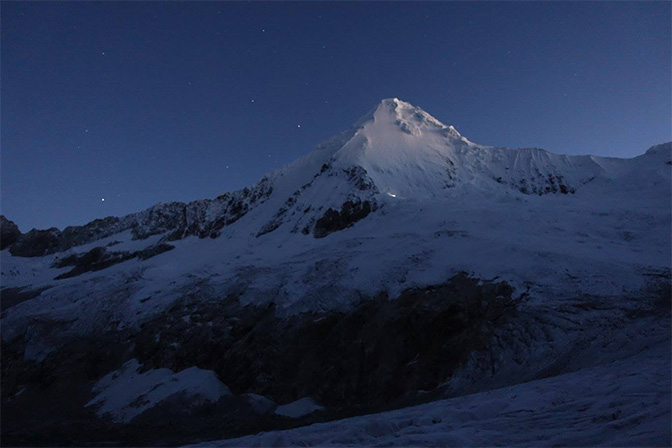
Pete and Jaz’s headlamps visible on the SE face of Artesonraju
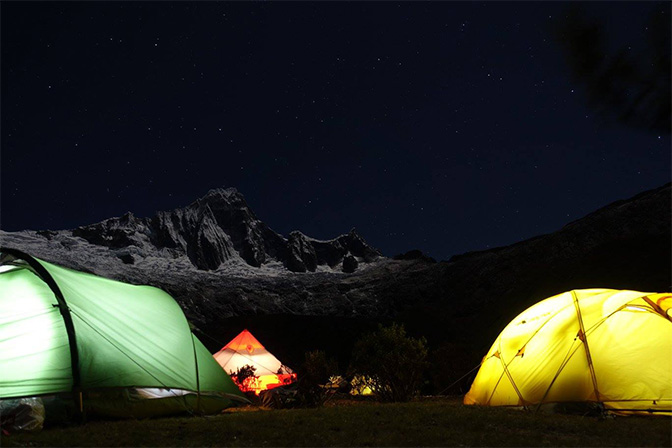
Night at Camp
ANZAC variation to the French Army Route – 17 June 2016
Daniel Joll, Steven Fortune & Matt Scholes
Another landmark achievement – these three made the first New Zealand and Australian ascents of Taulliraju on 17 June.
Having been in the Santa Cruz a couple of days, this eager team set off to scope the peak to see what challenges it held. Leaving base camp with the intention of attempting an established route – possibly the French Guides’ Route or the French Army Route – it was with some surprise that that same day, the rest of the team observed them ascending a line on the French Army buttress that was well left of the namesake line.
Encountering serious ice and mixed difficulties, they put up ten pitches on the buttress before meeting the SSE ridge where they bivouacked before climbing the classic route to the summit the following day – a historic achievement for both sides of the ditch!
Returning to their bivy, the team descended the Guides’ Route, putting in a valuable line for the other three groups to use.
East Rib of Taulliraju – 19 June 2016
Ben Dare & Stephen Skelton
Ben and Steve had a goal – a new route on the east side. The forecast was promising, so they started off with a warm up on the initial pitches of the French Guides’ Route to the bivy at the base of the SSE ridge. The next morning, they really hit the ground running, rapping over a seriously overhanging serac to gain access to the base of the East Face. With a third of the work done, all that remained was to climb the route, and get back down.
Wandering across snow slopes, the pair accessed the East Rib and were straight into 12 pitches of sunny rock climbing, dancing around the occasional patch of snow until they made the NE ridge. They settled on the far side to sleep on the North Face for the night.
The next day, a traverse, some mixed pitches and some ice pitches rounded out the full mountain experience. Summiting around midday on the 19th of June, they made their way leisurely back down the SSE ridge to their waiting tent.
As if the mountain was determined to somehow stymie their efforts, it threw in one stuck rope 20m off the ground the next day as the pair descended the Guides’ Route. A few hours of retrieval work later, and they were back at basecamp well in time for dinner!
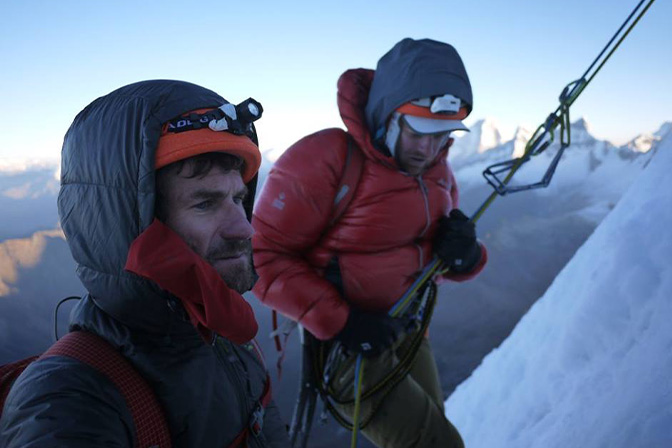
Steve and Dan abseiling Taulliraju
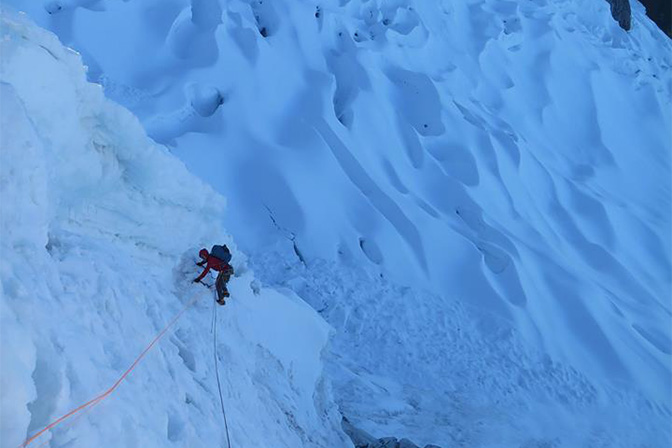
Ben traversing the lower section of the SSE Ridge
South Peak of Taulliraju – 21 June 2016
Steve Fortune, Alastair Mcdowell, Rose Pearson
All of the magazines and route guides at Basecamp failed to document any ascent of the prominent South Peak of Taulliraju. Enticed by the prospect of a day trip up this pyramidal peak, the trio set off bright and early to ascend the skyline ridge.
Whether previously ascended or not, the fresh rock-fall scars they scaled on the first couple of pitches likely heralded untrodden terrain. Another pitch, a step and a corkscrew around to the SE side for about seven pitches saw them top out on the South Peak with enough daylight for Rose and Alastair to scope the descent line down the SSE ridge for their ensuing West Ridge ascent.
Finishing the raps down the now well-trodden Guides’ Route in the dark, the team made it back just in time for a late supper and a rest day, before setting out on their historic ascent on the West Ridge.
The West Ridge of Taulliraju – 26 June 2016
Rose Pearson, Alastair McDowell, Reg Measures, Steven Fortune
For over two years, the Expedition Climbers Club has had the unclimbed West Ridge of Taulliraju in its sights. In this time, they have been ridiculed, chastised and vehemently discouraged from even considering it. In fact, Lionel Clay even contacted them early on, stating:
“It’s a bloody Peruvian Ridge, so if it has not been yet climbed, it goes without saying it will be for a very good reason.”
In the face of adversity, the dogmatism of youth triumphed, and on the 17th of June 2016, Rose, Jaz, Reg and Pete began their first attempt on the West Ridge. However, progress was slow and on day two they eventually turned around above a serious rock step, a third of the way up the route.
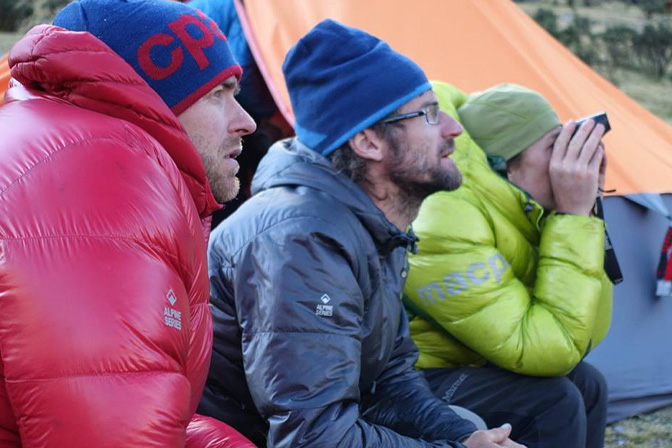
Who said Mountaineering isn’t a spectator sport? Dan, Steve and Matt watch all the action on Taulliraju from Taullipampa Base Camp
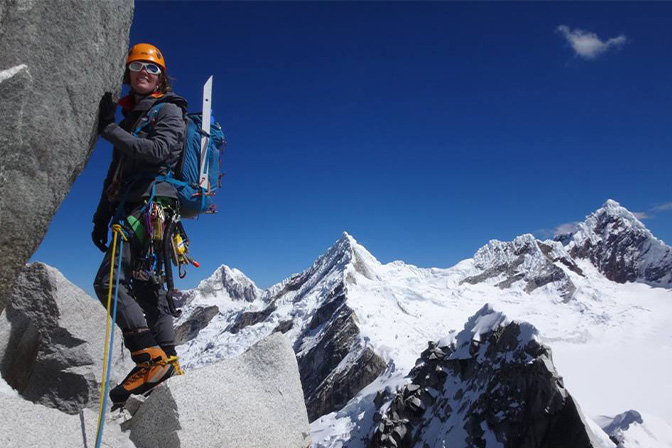
Rose on the second, successful attempt on the West Ridge
Refusing to admit defeat, Rose and fellow mentee Alastair were determined to take on another attempt on the ridge. However, progress above their previous attempt proved slow and arduous, and with dwindling food supplies, the pair faced at least one hungry night on the mountain.
Meanwhile, Reg and Steve had decided to also go for a second attempt the day after, so at this point all eyes at Basecamp turned to the West Ridge to watch the action unfold. Hot on the heels of Rose and Alastair, it took two days for the mentors to catch their eager students, a short distance from the summit. Together, the four of them overcame the final difficulties, and summited on the 26th of June – four days after Rose and Alastair set off from basecamp with three night’s food.
“What a ridge! Endless climbing with challenging route finding. But what’s more the climbing was immaculate. Rock, snow and ice. It has it all, and it was fun to climb! That being said, it was hard work. It’s a climb that Al and I will be stoked for a long time,” says Rose.
In summary
This inaugural expedition of the Expedition Climbers Club and the culmination of the New Zealand Alpine Team’s first rotation of students will be remembered for the superb mountaineering achievements on an international scale. Not only were four new routes climbed on Taulliraju, but three of these resulted in summits of the elusive peak, two of these were by entirely new routes, three new routes were climbed by Steve Fortune with a range of partners, and all of the aforementioned climbing was carried out in less than two weeks in pure alpine style.
Before the Taulliraju action, Al and Lincoln also summited Alpamayo via the French Direct, as did Dan, Reg and Matt (in just 1.5 hours!). Jaz and Pete also went up there, spending an extra day at Alpamayo High Camp and climbing Quitaraju the next day via the North Ridge.
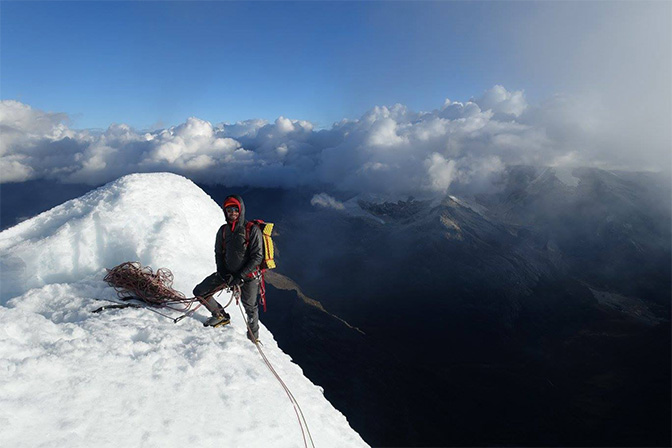
Steve Fortune on the summit of Taulliraju – second time for him on this trip, and third new route.
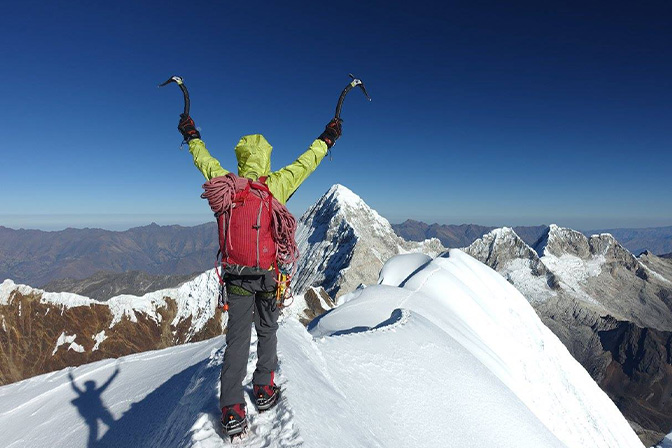
Quatiraju cumbre – 6040m – Jaz Morris
Dan and Matt also climbed what appeared to be a new line on Curicashajana on a rest day, and Lincoln and Ben tested out a new line on the Pucarashita, but backed off in the face of hideous serac threats to the approach.
All in all, a very successful trip, and for now, the planning has started on the next expedition.
“Next we are taking the new team members to Canada for a winter ice climbing trip in January. This will be the first trip of their three-year programme. Some of the mentors will then head to Nepal and Tibet later in the year,” says Dan.
Since 2013, Macpac has been working alongside the New Zealand Alpine Team to reinvent alpine gear. Our Alpine Series is the culmination of this partnership – a journey that has extended from the design floor, to testing and refinement on some of the world’s hardest alpine routes. Inspired by elite mountaineers, we’ve crafted a premium range of lightweight, pared-back apparel and equipment without compromise, giving you everything you need, and nothing you don’t.
